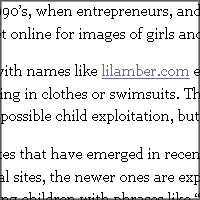 A lot of newspapers have been shy to link outside of their own news organization: so much so that it is almost a truism. They followed the corporate credo of keeping users on the site. That has changed over the last few years, with more and more traditional news sites willing to include hyperlinks.
A lot of newspapers have been shy to link outside of their own news organization: so much so that it is almost a truism. They followed the corporate credo of keeping users on the site. That has changed over the last few years, with more and more traditional news sites willing to include hyperlinks.
The New York Times has a very nicely done article on underaged model sites, sites that include images of (often barely) clothed minors in sexual poses. This is sometimes referred to as “legal child porn,” and while that certainly seems to be an oxymoron, it may not be entirely. While US v. Knox established a test that allowed for prosecution of those selling (and receiving) images of clothed minors under certain circumstances, it strikes me that pedophiles can turn any image of a child into pornography, if more explicit images are not available. In other words, unlike a lot of laws, while you are still held responsible for breaking the law, it’s not completely clear where that line is drawn.
Obviously, the solution is to get no where near anything that could be even possibly considered child pornography. But that’s easier said than done. On the “mainstream” porn side, there are extremely popular titles like “Barely Legal” that play to an appetite for youth. On the non-pornographic side, there are the millions of parents who think nothing of taking pictures of their children in the bath, or nursing–photographs that have gotten people in trouble for producing child porn.
The Times article links directly to the lilamber website, as an example of the progenitor of this phenomenon, noting that the new sites tend to be more explicit in their language, if not their images. (As an aside, I am terrible at judging age, and while “lilamber” is clearly young, I can see how someone would mistaken her for being over the age of 18, perhaps.) This follows on the recent arrests in the UK over what is sometimes called “virtual child pornography.”
But the editorial policy of linking to the lilamber.com site (which I have done above) is interesting. One one hand, by providing the name of the site, they have effectively given the reader enough information to find the site. Actually making it a hyperlink is merely a convenience and a pretty common thing for bloggers to do, for example, as a service to their readers. However, it isn’t a convenience offered elsewhere in the article. Indeed, this is the only external link in the article, which affords it some importance.
As the article itself notes, they quickly ran into sites they found to display child pornography in their own investigation. Under such circumstances, is it responsible to shunt readers off to a site that is on the questionable border of such material? Does the Times have a clear policy as to what it does and does not link to?
One Comment
I copped out by just providing a link to your article that discusses the links. How many degrees of separation are necessary.